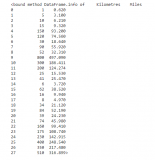在上一讲中,我们学习了如何利用numpy手动搭建卷积神经网络。但在实际的图像识别中,使用numpy去手写 CNN 未免有些吃力不讨好。在 DNN 的学习中,我们也是在手动搭建之后利用Tensorflow去重新实现一遍,一来为了能够对神经网络的传播机制能够理解更加透彻,二来也是为了更加高效使用开源框架快速搭建起深度学习项目。本节就继续和大家一起学习如何利用Tensorflow搭建一个卷积神经网络。
我们继续以 NG 课题组提供的 sign 手势数据集为例,学习如何通过Tensorflow快速搭建起一个深度学习项目。数据集标签共有零到五总共 6 类标签,示例如下:
先对数据进行简单的预处理并查看训练集和测试集维度:
X_train = X_train_orig/255.X_test = X_test_orig/255.Y_train = convert_to_one_hot(Y_train_orig, 6).T Y_test = convert_to_one_hot(Y_test_orig, 6).Tprint ("number of training examples = " + str(X_train.shape[0]))print ("number of test examples = " + str(X_test.shape[0]))print ("X_train shape: " + str(X_train.shape))print ("Y_train shape: " + str(Y_train.shape))print ("X_test shape: " + str(X_test.shape))print ("Y_test shape: " + str(Y_test.shape))
可见我们总共有 1080 张 64643 训练集图像,120 张 64643 的测试集图像,共有 6 类标签。下面我们开始搭建过程。
创建placeholder
首先需要为训练集预测变量和目标变量创建占位符变量placeholder,定义创建占位符变量函数:
def create_placeholders(n_H0, n_W0, n_C0, n_y): """ Creates the placeholders for the tensorflow session. Arguments: n_H0 -- scalar, height of an input image n_W0 -- scalar, width of an input image n_C0 -- scalar, number of channels of the input n_y -- scalar, number of classes Returns: X -- placeholder for the data input, of shape [None, n_H0, n_W0, n_C0] and dtype "float" Y -- placeholder for the input labels, of shape [None, n_y] and dtype "float" """ X = tf.placeholder(tf.float32, shape=(None, n_H0, n_W0, n_C0), name='X') Y = tf.placeholder(tf.float32, shape=(None, n_y), name='Y') return X, Y
参数初始化
然后需要对滤波器权值参数进行初始化:
def initialize_parameters(): """ Initializes weight parameters to build a neural network with tensorflow. Returns: parameters -- a dictionary of tensors containing W1, W2 """ tf.set_random_seed(1) W1 = tf.get_variable("W1", [4,4,3,8], initializer = tf.contrib.layers.xavier_initializer(seed = 0)) W2 = tf.get_variable("W2", [2,2,8,16], initializer = tf.contrib.layers.xavier_initializer(seed = 0)) parameters = {"W1": W1, "W2": W2} return parameters
执行卷积网络的前向传播过程
前向传播过程如下所示:CONV2D -> RELU -> MAXPOOL -> CONV2D -> RELU -> MAXPOOL -> FLATTEN -> FULLYCONNECTED
可见我们要搭建的是一个典型的 CNN 过程,经过两次的卷积-relu激活-最大池化,然后展开接上一个全连接层。利用Tensorflow搭建上述传播过程如下:
def forward_propagation(X, parameters): """ Implements the forward propagation for the model Arguments: X -- input dataset placeholder, of shape (input size, number of examples) parameters -- python dictionary containing your parameters "W1", "W2" the shapes are given in initialize_parameters Returns: Z3 -- the output of the last LINEAR unit """ # Retrieve the parameters from the dictionary "parameters" W1 = parameters['W1'] W2 = parameters['W2'] # CONV2D: stride of 1, padding 'SAME' Z1 = tf.nn.conv2d(X,W1, strides = [1,1,1,1], padding = 'SAME') # RELU A1 = tf.nn.relu(Z1) # MAXPOOL: window 8x8, sride 8, padding 'SAME' P1 = tf.nn.max_pool(A1, ksize = [1,8,8,1], strides = [1,8,8,1], padding = 'SAME') # CONV2D: filters W2, stride 1, padding 'SAME' Z2 = tf.nn.conv2d(P1,W2, strides = [1,1,1,1], padding = 'SAME') # RELU A2 = tf.nn.relu(Z2) # MAXPOOL: window 4x4, stride 4, padding 'SAME' P2 = tf.nn.max_pool(A2, ksize = [1,4,4,1], strides = [1,4,4,1], padding = 'SAME') # FLATTEN P2 = tf.contrib.layers.flatten(P2) Z3 = tf.contrib.layers.fully_connected(P2, 6, activation_fn = None) return Z3
计算当前损失
在Tensorflow中计算损失函数非常简单,一行代码即可:
def compute_cost(Z3, Y): """ Computes the cost Arguments: Z3 -- output of forward propagation (output of the last LINEAR unit), of shape (6, number of examples) Y -- "true" labels vector placeholder, same shape as Z3 Returns: cost - Tensor of the cost function """ cost = tf.reduce_mean(tf.nn.softmax_cross_entropy_with_logits(logits=Z3, labels=Y)) return cost
定义好上述过程之后,就可以封装整体的训练过程模型。可能你会问为什么没有反向传播,这里需要注意的是Tensorflow帮助我们自动封装好了反向传播过程,无需我们再次定义,在实际搭建过程中我们只需将前向传播的网络结构定义清楚即可。
封装模型
def model(X_train, Y_train, X_test, Y_test, learning_rate = 0.009, num_epochs = 100, minibatch_size = 64, print_cost = True): """ Implements a three-layer ConvNet in Tensorflow: CONV2D -> RELU -> MAXPOOL -> CONV2D -> RELU -> MAXPOOL -> FLATTEN -> FULLYCONNECTED Arguments: X_train -- training set, of shape (None, 64, 64, 3) Y_train -- test set, of shape (None, n_y = 6) X_test -- training set, of shape (None, 64, 64, 3) Y_test -- test set, of shape (None, n_y = 6) learning_rate -- learning rate of the optimization num_epochs -- number of epochs of the optimization loop minibatch_size -- size of a minibatch print_cost -- True to print the cost every 100 epochs Returns: train_accuracy -- real number, accuracy on the train set (X_train) test_accuracy -- real number, testing accuracy on the test set (X_test) parameters -- parameters learnt by the model. They can then be used to predict. """ ops.reset_default_graph() tf.set_random_seed(1) seed = 3 (m, n_H0, n_W0, n_C0) = X_train.shape n_y = Y_train.shape[1] costs = [] # Create Placeholders of the correct shape X, Y = create_placeholders(n_H0, n_W0, n_C0, n_y) # Initialize parameters parameters = initialize_parameters() # Forward propagation Z3 = forward_propagation(X, parameters) # Cost function cost = compute_cost(Z3, Y) # Backpropagation optimizer = tf.train.AdamOptimizer(learning_rate = learning_rate).minimize(cost) # Initialize all the variables globally init = tf.global_variables_initializer() # Start the session to compute the tensorflow graph with tf.Session() as sess: # Run the initialization sess.run(init) # Do the training loop for epoch in range(num_epochs): minibatch_cost = 0. num_minibatches = int(m / minibatch_size) seed = seed + 1 minibatches = random_mini_batches(X_train, Y_train, minibatch_size, seed) for minibatch in minibatches: # Select a minibatch (minibatch_X, minibatch_Y) = minibatch _ , temp_cost = sess.run([optimizer, cost], feed_dict={X: minibatch_X, Y: minibatch_Y}) minibatch_cost += temp_cost / num_minibatches # Print the cost every epoch if print_cost == True and epoch % 5 == 0: print ("Cost after epoch %i: %f" % (epoch, minibatch_cost)) if print_cost == True and epoch % 1 == 0: costs.append(minibatch_cost) # plot the cost plt.plot(np.squeeze(costs)) plt.ylabel('cost') plt.xlabel('iterations (per tens)') plt.title("Learning rate =" + str(learning_rate)) plt.show() # Calculate the correct predictions predict_op = tf.argmax(Z3, 1) correct_prediction = tf.equal(predict_op, tf.argmax(Y, 1)) # Calculate accuracy on the test set accuracy = tf.reduce_mean(tf.cast(correct_prediction, "float")) print(accuracy) train_accuracy = accuracy.eval({X: X_train, Y: Y_train}) test_accuracy = accuracy.eval({X: X_test, Y: Y_test}) print("Train Accuracy:", train_accuracy) print("Test Accuracy:", test_accuracy) return train_accuracy, test_accuracy, parameters
对训练集执行模型训练:
_, _, parameters = model(X_train, Y_train, X_test, Y_test)
训练迭代过程如下:
我们在训练集上取得了 0.67 的准确率,在测试集上的预测准确率为 0.58 ,虽然效果并不显著,模型也有待深度调优,但我们已经学会了如何用Tensorflow快速搭建起一个深度学习系统了。
注:本深度学习笔记系作者学习 Andrew NG 的 deeplearningai 五门课程所记笔记,其中代码为每门课的课后assignments作业整理而成。
-
神经网络
+关注
关注
42文章
4562浏览量
98625 -
深度学习
+关注
关注
73文章
5219浏览量
119860 -
tensorflow
+关注
关注
13文章
313浏览量
60240
原文标题:深度学习笔记12:卷积神经网络的Tensorflow实现
文章出处:【微信号:AI_shequ,微信公众号:人工智能爱好者社区】欢迎添加关注!文章转载请注明出处。
发布评论请先 登录
相关推荐
FPGA在深度学习应用中或将取代GPU
PyTorch与TensorFlow的优点和缺点





 如何使用tensorflow快速搭建起一个深度学习项目
如何使用tensorflow快速搭建起一个深度学习项目











评论